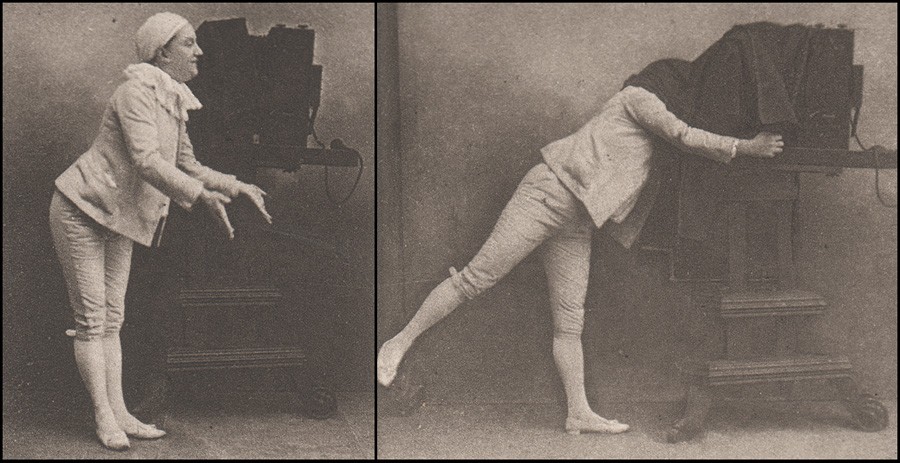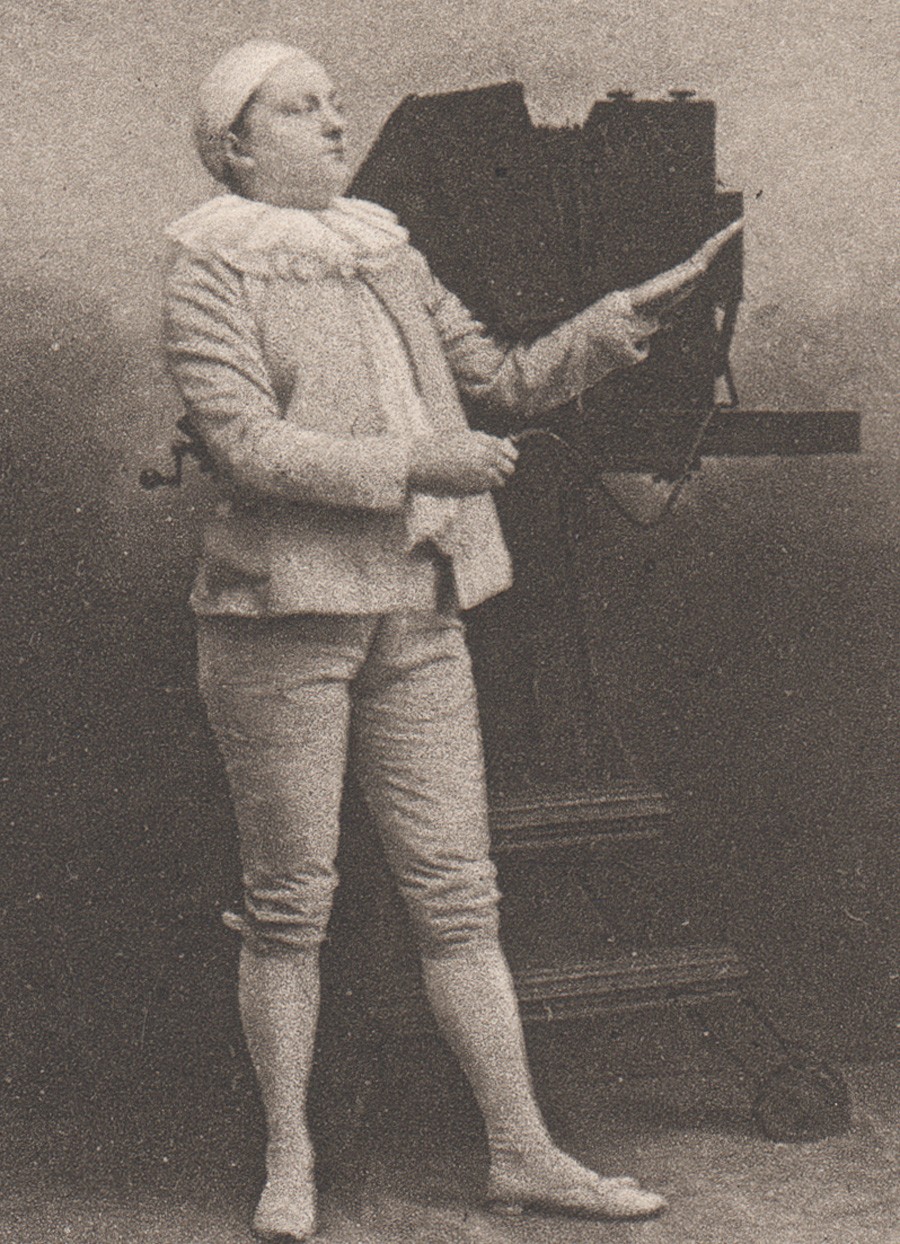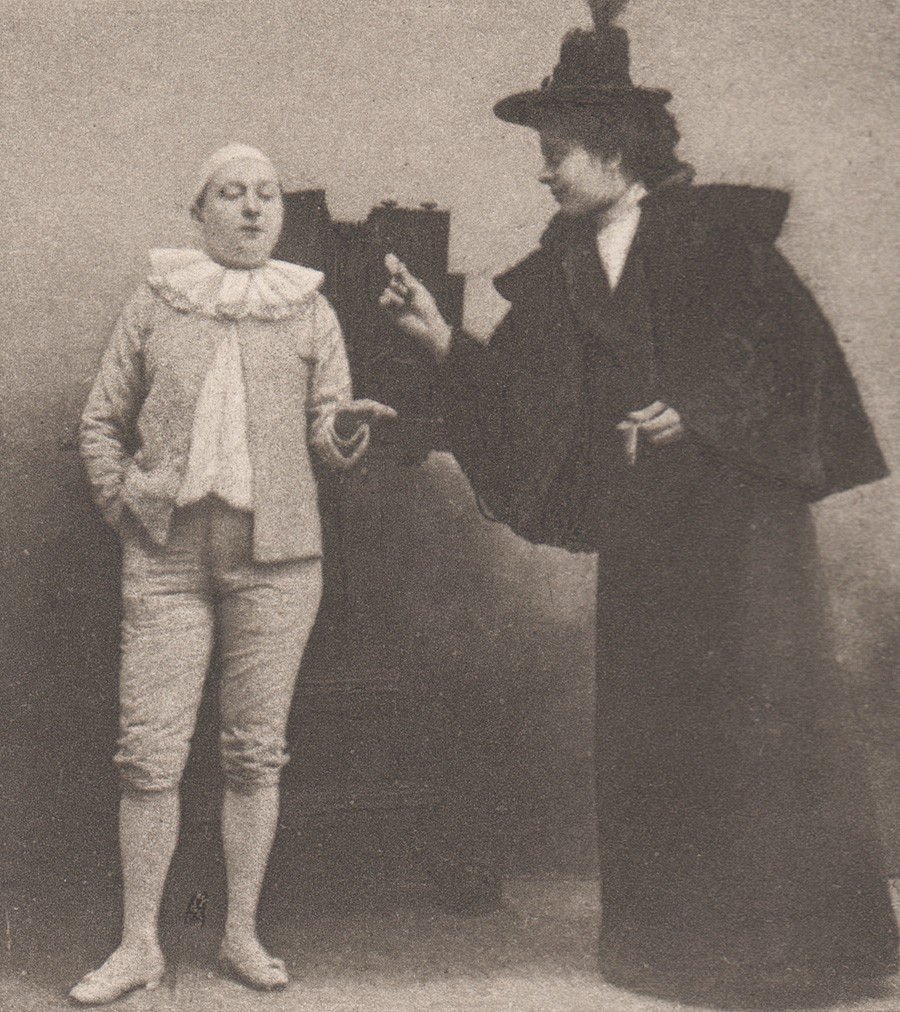Besides the obvious: a permanent, for the most part, result in the form of a photograph; the act of taking said photograph could be argued as being just as important. For some, it really is the point.

Left: Pantomime clown Pierrot played by French actress Félicia Mallet (1863-1928) introduces himself to subject in the Photography studio. Right: Pierrot steps underneath the dark cloth while focusing the camera. Details-both: (5.7 x 4.3 cm & 5.7 x 5.4 cm) Arthur da Cunha: “Pierrot Photographe”: vintage hand-pulled photogravure from March, 1896 issue of the Bulletin du Photo-Club de Paris: PhotoSeed Archive
Can I take your picture? Why sure. Why would you be interested may I ask? Because…
I find you: insert adjective here. Or don’t ask permission.
Because. No real reason at all, other than it sorta confirms your existence for posterity. So not a bad tradeoff, especially for those who might want to look back, far off in the future, or five minutes from now.

Pantomime clown Pierrot played by French actress Félicia Mallet (1863-1928) places the film back into the rear of the studio camera. Detail: (5.7 x 4.3 cm) Arthur da Cunha: “Pierrot Photographe”: vintage hand-pulled photogravure from March, 1896 issue of the Bulletin du Photo-Club de Paris: PhotoSeed Archive
Going back well over a century, this series of photographs is confirmation act has always been wrapped up in art. For proof, observe the capable body language of voiceless French actress Félicia Mallet, (1863–1928) published in 1896 and recently posted. As Pierrot, she was taking on the role modern scholars consider the essence of the artist’s alter-ego. Especially as some might consider: “the famously alienated artist of the nineteenth and early twentieth centuries.” (1.)

Pantomime clown Pierrot played by French actress Félicia Mallet (1863-1928) instructs subject to be still while preparing to release bulb shutter on studio camera. Detail: (5.7 x 4.3 cm) Arthur da Cunha: “Pierrot Photographe”: vintage hand-pulled photogravure from March, 1896 issue of the Bulletin du Photo-Club de Paris: PhotoSeed Archive
But the inherently silent results recorded by French photographer Arthur da Cunha here are besides the point. A live performance will always elicit a critic, particularly one on the public stage.

Pantomime clown Pierrot played by French actress Félicia Mallet (1863-1928) holds out hand to receive payment from subject for taking photograph. Detail: (5.7 x 5.4 cm) Arthur da Cunha: “Pierrot Photographe”: vintage hand-pulled photogravure from March, 1896 issue of the Bulletin du Photo-Club de Paris: PhotoSeed Archive
In a fortunate coincidence, no less an observer than George Bernard Shaw weighed in a year later, his take on Mallet’s performance during the London stage production of A Pierrot’s Life giving readers the opinion her Pierrot was far more believable than one played by (Mrs.) Signora Litini:
The recasting of “A Pierrot’s Life” at the matinees at the Prince of Wales’ Theatre greatly increases and solidifies the attraction of the piece. Felicia Mallet now plays Pierrot; but we can still hang on the upturned nose of the irresistible Litini, who reappears as Fifine. Litini was certainly a charming Pierrot; but the delicate, subtle charm was an intensely feminine one, and only incorporated itself dreamily with the drama in the tender shyness of the first act and the pathos of the last. Litini as a vulgar drunkard and gambler was as fantastically impossible as an angel at a horse-race. Felicia Mallet is much more credible, much more realistic, and therefore much more intelligible — also much less slim, and not quite so youthful. Litini was like a dissolute “La Sylphide”: Mallet is frankly and heartily like a scion of the very smallest bourgeoisie sowing his wild oats. She is a good observer, a smart executant, and a vigorous and sympathetic actress, apparently quite indifferent to romantic charm, and intent only on the dramatic interest, realistic illusion, and comic force of her work. And she avoids the conventional gesture-code of academic Italian pantomime, depending on popularly graphic methods throughout. The result is that the piece is now much fuller of incident, much more exciting in the second act (hitherto the weak point) and much more vivid than before. (2.)

Performance complete. Pantomime clown Pierrot played by French actress Félicia Mallet (1863-1928) acknowledges applause for taking photograph. Detail: (5.7 x 4.3 cm) Arthur da Cunha: “Pierrot Photographe”: vintage hand-pulled photogravure from March, 1896 issue of the Bulletin du Photo-Club de Paris: PhotoSeed Archive
Notes:
1. Pierrot: see: Wikipedia overview: accessed, March, 2014
2. excerpt: Meredith on Comedy: An Essay on Comedy. By George Meredith. Westminster: Archibald Constable & Co. 1897: from: Dramatic Opinions and Essays by G. Bernard Shaw/(James Huneker): Volume 2: New York: Brentanos: 1906: pp. 225-6



